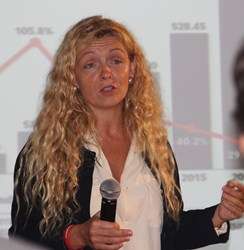The THRIVE project would like to extend warm gratitude to Daxita Rajcoomar and Valerie Itey for their presentation at the April Thrivability Matters webinar. The focus of this webinar was the United Nations SDG13 – Climate Action. Daxita drew on her expertise in the sustainability sector to speak about the importance of decarbonisation solutions as part of the Climate Adaptation race to zero. Valerie’s discussion merged the technology industry with Climate Action to explore the concept of a circular economy and the essence of ethical and responsible use of technology.
About our speakers

Daxita Rajcoomar has over 18 years experience in the sustainability sector where she is an established thought leader and influencer. Daxita works for ENGIE, which is an organisation that looks at strategic directions, to support energy transitions, in order to achieve the goal of net-zero emissions by 2045. Daxita’s role at ENGIE is Chief Sustainability Officer, overlooking the scope of Asia, the Middle East and Africa.

Valerie Itey has 20 years experience in developing the brand value of businesses through digital media. Over the last 15 years, Valerie has worked towards achieving the UN’s SDGs and creating a better world via technology. Valerie is the founding CEO of Clic Recyclable whose aim is to educate and create recycling programs to move the world towards a circular economy.
Summary of the webinar
Daxita Rajcoomar on the topic of The Race to Zero
Daxita began her presentation by discussing the importance of being able to open a dialogue about sustainability issues now rather than later. It has been prevalent in the media coverage headlines, just as it is widespread knowledge, that we are at a critical point of ‘it’s now or never’ to address climate change. As the IPC’s 2021 report stated, to be able to work towards the trajectory of 1.5°C or remain under 2°C, meaningful action needs to come into effect before 2030.
Daxita firstly acknowledges that there needs to be more awareness and education in the general public if these goals are to be met. This is primarily because the temperature changes of 1.5°C and 2°C appear numerically marginal and without meaningful consequences through the eyes of the non-scientific. To put these numbers into perspective, Daxita highlighted the ramifications that will occur.
A +1.5°C increase equates to a 3% probability of ice-free arctic summers, length of droughts averaging 2 months, 4% of mammals would lose half their habitat and there would be a +41% increase in areas burnt by wildfire. The stakes are grimly magnified when you look at the consequences of a global temperature increase of +3°C. There would be a 63% probability of ice-free arctic summers, average lengths of droughts would increase to 10 months, 41% of mammals would lose half their habitats, and areas destroyed by wildfire would increase by +97%.
Daxita points out that these are not just isolated consequences either, there would be domino effects. As an example, Daxita posits that the increased length of droughts would cause an agricultural decline in which the increased prices on commodities would displace more people beneath the line of poverty.
Whilst the consequences are dire, the solutions are entirely possible. Currently, humans are emitting too much carbon and the natural process is unable to deal with the copious amounts of CO2, hence climate change. Given that the Energy sector contributes to 45% of total global emissions, Daxita proposes that there needs to be an immediate transition, where businesses and governments adopt clean and green energy sources into their portfolios sooner rather than later.
In order to achieve this mission, ENGIE is committed to a trajectory that is aligned with the Paris Agreement. ENGIE looks at strategic directions to achieve the science-based targets of keeping global temperature increases below 1.5°C and building adaptation plans to support the 2030 trajectory. Daxita discusses the importance of carbon sequestration and the Blue Carbon Project that ENGIE invested in. Blue Carbon plants mangroves using drones and has a 35-40% growth rate, relatively high compared to the 5% growth rate in natural settings. Mangroves are planted because they are able to naturally sequest 4x more carbon than any other trees. Due to the high growth rates of the mangroves, the Blue Carbon Project is the first successful project of this calibre.
Daxita closes her presentation by expressing the importance of everyone, from governments to business owners to individuals, working together in order to achieve meaningful and impactful climate action, such as achieving net zero by 2045.
Valerie Itey on the topic of Tech Industry and Climate Action
Valerie began her presentation by delving into what technology is doing with Climate Change. To structure her discussion, Valerie explains the aim of Clic Recyclable which is to build recycling programs, educate individuals, and to create a platform in which waste can be given and found, alluding to a circular economy.
A circular economy is truly the way forward given that it is about using or reusing waste as a resource, bypassing it on to someone who has functional use for waste that you would otherwise throw out. As Valerie states, reducing waste is always better than recycling, but when we need to recycle, it is important that we improve this system globally.
When it comes to global carbon emissions, Valerie stresses that clean air is for all humans and all other living species. Valerie goes on to state the 6 key sectors to focus on, which are transport, energy, agriculture, construction and architecture, manufacturing, and health. Valerie proposes solutions within each sector to improve the quality of air and strive toward a net-zero trajectory. For the transport sector, Valerie highlights the positive climate action impact riding a bicycle or using ride-sharing services can have. Within the energy sector, Valerie uses Africa’s MOON project to discuss how sound data collection and control is key to being able to adapt to climate change. Pertaining to the agricultural sector, 76% of food is being lost due to unsustainable production methods. While Valerie does acknowledge the good that is being seen with initiatives such as regenerative agriculture and packaging that avoids plastic, Valerie stresses the importance of acting locally but thinking globally.
Next, smart construction and architecture is important for sustainable energy production, through methods such as using smart sensors and mobiles. Also, in construction, there tends to be much waste and pollution. Valerie highlights the need to innovate new ways to transform waste into resources and to formulate new manufacturing processes that are more sustainable. The last key sector Valerie touches upon is smart health where she illustrates that all climate change impacts, from rising ocean temperatures to melting arctic ice caps, can have negative implications on human health.
Valerie’s presentation makes another powerful statement, in which she describes how our use of technology is adversely affecting climate change. Valerie posits that with the rise of social media, personal mobile phone usage and so forth, we need to take care of how we are using technology as too much usage is damaging. Valerie explains how typing on a device and storing data on a cloud server consumes copious amounts of energy. Valerie proposed that efforts to educate people and companies to build, deploy and run energy efficiency are key to striving toward the SDG of Climate Action. Valerie concludes by illustrating the three predictions of responsible technology: 1) essence of responsible investment in technology, 2) targeted technology regulations, and 3) ethical technology to be mandatory in universities and other higher school education.
As founding CEO of Clic Recyclable, Valerie stands true to her company’s mission statement which is “savoir-faire un nouveau monde”, translated to “having the knowledge to create a new world”.
Her presentation and conclusion can be seen here.
CONCLUSION
To summarise the discussion points stated by Daxita and Valerie, striving towards the UN’s SDG13 – Climate Action, it is important that everyone works together to stay on the trajectory for net-zero emissions. In this context, the term everyone not only encompasses the policymakers, governments, and organisations, but also down to the individual level. In order to mitigate and adapt to climate change, it is important to first raise awareness, educate and incentivise all global communities. Otherwise, if we allow the world to continue on its current trajectory, it is within this lifetime that we will suffer dire consequences.
Following this webinar, participants were invited to take part in an interactive Q&A session in which Daxita and Valerie answered the audience’s questions.
If you missed out on the presentation, you can view the recording on our YouTube channel.
Make sure to register for May’s webinar here or find out more info here.
Thanks, and do keep on thriving!
SUBSCRIBE TO OUR NEWSLETTER
GOT A QUESTION ON THIS TOPIC?























